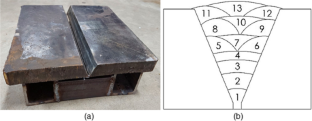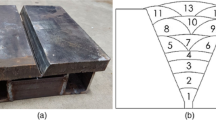Abstract
There are several ways to relieve welding residual stresses. The most commonly used and the only standardized method is the post-weld heat treatment. However, this method is time-consuming and costly, which necessitates exploring other approaches that can ensure satisfactory results in a faster and more economical manner. In this context, the industry has gradually adopted relief of residual stresses through vibration. Therefore, this study aims to relieve welding residual stresses in thick plates to evaluate whether the position of the excitation source, whether parallel or coincident with the welded plates, influences the expected results. Additionally, it seeks to determine whether the best results are obtained when vibration stress relief is performed simultaneously with welding or after the completion of the process. It was verified that the parallel position presented a maximum reduction of 63.7% in residual stresses when performed after welding, while the parallel and coincident position during the welding reduced a maximum of 2.5% and 56.0% of residual stresses, respectively. Furthermore, mechanical tests are conducted to determine the influence of these processes on mechanical properties. The results indicated that performed vibration after welding is more efficient, and the vibration motor’s position significantly influences the results. Furthermore, it was observed that the only impacted toughness without altering significant other mechanical properties.







Similar content being viewed by others
Data availability
The data that support the findings of this study are available from the corresponding author, upon reasonable request.
References
Samardžić I et al (2015) Influence of vibrations on residual stresses stress relief by vibrations. Metalurgija 54(3):527–530
Walker CA, Waddell AJ, Johnston DJ (1995) Vibratory stress relief—an investigation of the underlying processes. Proc Inst Mech Eng E: J Process Mech Eng 209(1):51–58
Munsi ASMY, Waddell AJ, Walker CA (2001) The influence of vibratory treatment on the fatigue life of welds: a comparison with thermal stress relief. Strain 37(4):141–149. https://doi.org/10.1111/j.1475-1305.2001.tb01250.x
Dawson R, Moffat DG (1980) Vibratory stress relief: a fundamental study of its effectiveness. J Eng Mater Technol Trans ASME 102(2):169–176. https://doi.org/10.1115/1.3224793
Jurčius A et al (2010) Influence of vibratory stress relief on residual stresses in weldments and mechanical properties of structural steel joint. J Vibroeng 12(1):133–141
Sun MC, Sun YH, Wang RK (2004) Vibratory stress relieving of welded sheet steels of low alloy high strength steel. Mater Lett 58(7–8):1396–1399. https://doi.org/10.1016/j.matlet.2003.10.002
Martins CAP et al (2018) Alívio de tensões por vibrações sub-ressonantes: análise e parametrização. Material (Rio de Janeiro) 23(1). https://doi.org/10.1590/s1517-707620170001.0309
Rao D et al (2007) The effectiveness evaluation of 314L stainless steel vibratory stress relief by dynamic stress. Int J Fatigue 29(1):192–196. https://doi.org/10.1016/j.ijfatigue.2006.02.047
Wong TE, Johnson GC (1988) Ultrasonic evaluation of the nonlinearity of metals from a design perspective. Rev Prog Quantitative Nondestruct Eval 7B:1203–1210. https://doi.org/10.1007/978-1-4613-0979-6_39
Bolina CC, Palechor EUL, Vásquez MPR (2015) Vibrações: As Frequências Naturais Estimada E Experimental De Uma Estrutura. p. 186–194. https://doi.org/10.5151/mathpro-cnmai-0038
Ingram E et al (2019) The effect of localized vibration during welding on the microstructure and mechanical behavior of steel welds. Materials 12(16). https://doi.org/10.3390/ma12162553
Munsi ASMY (1999) Investigation and validation of vibratory methods for stress relieving and weld conditioning. PhD Thesis - Mechanical Engineering. University of Strathclyde, Glasgow, UK, p 535
Callister W, Rethwisch D (2007) Materials science and engineering: an introduction. York, PA: John Wylen & Sons, Inc, v. 94
Hassan AH (2014) Fundamentals of vibratory stress relief. Asian J Appl Sci 7(5):317–324. https://doi.org/10.3923/ajaps.2014.317.324
Walker C (2011) A theoretical review of the operation of vibratory stress relief with particular reference to the stabilization of large-scale fabrications. Proc Inst Mecha Eng Part L: J Mater: Design Appl 225(3):195–204. https://doi.org/10.1177/0954420711402877
Shankar S (1982) Vibratory stress relief of mild steel weldments. PhD Thesis - Materials Science. Bangalore University, Bangalore, India, p 128
Prohaszka J, Hidasi B, Varga L (1975) Vibration-induced internal stress relief. Period Polytech Mech Eng 19(1):69–78
Shalvandi M et al (2013) Influence of ultrasonic stress relief on stainless steel 316 specimens: a comparison with thermal stress relief. Mater Design 46:713–723. https://doi.org/10.1016/j.matdes.2012.11.023
Modenesi Paulo, Marques Paulo, Santos Dagoberto (2012) Introdução à metalurgia da soldagem. Federal University of Minas Gerais, Belo Horizonte, Brazil, p 21
Li S et al (2016) Inter-pass thermal-vibration stress relief on multi-pass welded joints of DH 36 steel. Adv Mater Sci Eng (AMSE2016) Anais World Scientific. https://doi.org/10.1142/9789813141612_0073
ASTM A370 (2020) A370: standard test methods and definitions for mechanical testing of steel products. ASTM International, pp 1–50
Stress Relief Engineering Company (1990) Resonant vibration method for reducing residual stresses in welded or machined fabrication. Costa Mesa, California, USA
Rao PG, Rao PS, Krishna AG (2014) Impact strength improvement of butt welded joints prepared by vibratory welding process. J Manuf Technol Manag 6(3/4):143
Serrati DSM (2019) Thermal Analysis of Multipass Welding via Finite Elements. Graduation Project, vol 40. Federal University of Uberlandia, Brazil
Serrati DSM, Araújo Douglas B, Vilarinho Louriel O (2023) Thermal-Structural Plasma Gouging Simulation for Welding Repair. Soldagem & Inspeção 28:e2807. https://doi.org/10.1590/0104-9224/SI28.07
Xu JJ, Chen LG, Ni CZ (2006) Effects of vibratory weld conditioning on residual stresses and transverse contraction distortions in multipass welding. Sci Technol Weld Join 11(4):374–378. https://doi.org/10.1179/174329306X113325
Zhao X, Zhang Y, Ma Y (2011) Finite element analysis of vibratory stress relief process. In: Applied Mechanics and Materials. Trans Tech Publications Ltd, pp 623–627. https://doi.org/10.4028/www.scientific.net/AMM.88-89.623
Serrati DS, Silva RM, Wiezel JG, Cunha DB, de Araújo DB, Vilarinho LO (2023) Effects of heat and vibration treatments for welding on residual stresses and mechanical properties. Int J Adv Manuf Technol 128:1473–1481. https://doi.org/10.1007/s00170-023-12011-x
IOGP(S-705) (2020) Supplementary specification to API recommended practice 582 for welding of pressure containing equipment and piping. Joint Ind Programe 33 (JIP33) 33(S-705):55
AWS D1.1, D1.1M (2020) Structural Welding Code - Steel, 24th edn. American Welding Society Inc, Danvers, MA, p 2020
Viii ASME, - DIV1 (2019) Rules for Construction of Pressure Vessels, 2019th edn. ASME International, New York, NY, p 2019
Funding
This research is supported by Petrobras, ANP, CAPES, CNPq, and FAPEMIG.
Author information
Authors and Affiliations
Contributions
All authors contributed at all stages of the article. All authors have read and agreed to the published version of the manuscript.
Corresponding authors
Ethics declarations
Conflict of interest
The authors declare no competing interests.
Additional information
Publisher's Note
Springer Nature remains neutral with regard to jurisdictional claims in published maps and institutional affiliations.
Rights and permissions
Springer Nature or its licensor (e.g. a society or other partner) holds exclusive rights to this article under a publishing agreement with the author(s) or other rightsholder(s); author self-archiving of the accepted manuscript version of this article is solely governed by the terms of such publishing agreement and applicable law.
About this article
Cite this article
Serrati, D.S.M., Silva, R.M., de Souza, D.D.B.G. et al. Variation of the vibrational treatment on mechanical properties and weld residual stress. Int J Adv Manuf Technol 131, 5037–5046 (2024). https://doi.org/10.1007/s00170-024-13318-z
Received:
Accepted:
Published:
Issue Date:
DOI: https://doi.org/10.1007/s00170-024-13318-z



